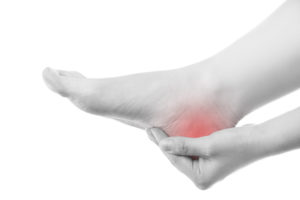Sever’s Disease
Sever’s Disease (calcaneal apophysitis) is a widespread pathology in children between 8 and 14 years old. In this period, the calcaneal bone is developing, growing in two parts connected by cartilage, also called “growth plates”.
This Disease causes extreme pain in children’s heels. Pain in the back of the foot is frequent in this condition due to inflammation in the calcaneal apophysis (area of calcaneal growth) that affects children and adolescents who frequently practice physical activity.
Sever’s Disease is not always bilateral (when both heels are affected); 40% of individuals with the problem claim it to be in just one foot.
Sever’s Disease is also known as calcaneal apophysitis. It occurs from exacerbated use of the heel bone and tendon in physical activities, thus generating several microtraumas in the cartilage that connects the two parts of the bones. As a result, the heel may present swelling and a slight increase in the local temperature.

CAUSES
The causes of Sever’s Disease are still little known. However, it is possible to associate its appearance with the child’s growth and when the child usually practices high-impact exercises.
Check out some of the most common causes associated with pathology:
- Rapid bone growth compared to muscles;
- Muscle or Achilles tendon shortening;
- Overweight;
- Dysmetria (when, for example, one leg is longer than the other);
- Pronated foot (feet turned outward).
SIGNS AND SYMPTOMS
As previously mentioned, Sever’s Disease causes a lot of pain in the child’s heel, mainly if he regularly practices physical exercises.
The pain is localized around the edge of the heel. It can cause a change in the child’s gait pattern, causing increased overload on the lateral part of the foot. Such an alteration can cause several other complications.
Check out all the symptoms of this pathology:
- Heel pain or tenderness;
- Discomfort in the heel when waking up or when under pressure;
- Limping;
- Intense pain after walking or physical exercise, as well as greater difficulty in standing;
- Pain when running or playing sports that tends to decrease with rest;
- Slight heel swelling;
- Slight calcaneal widening;
- Edema in the affected area;
- Slight temperature increase.
The complication can worsen if the patient does not start an adequate treatment. It may also cause other problems, such as functional limitation, loss of flexibility, and muscle shortening in the back of the foot.
DIAGNOSIS FOR SEVER’S DISEASE
Seek a specialized doctor to diagnose your pain correctly and indicate the appropriate treatment.
The diagnosis is made based on the child’s history and clinical manifestations. However, a detailed diagnosis can also be obtained by thorough examinations.
To identify Sever’s Disease, ultrasound, x-ray, and magnetic resonance imaging are performed. These exams are crucial to assess the severity of the injury.
Radiography can identify an increase in bone density in the projection of the calcaneal apophysis and the growth of adjacent soft tissues. On the other hand, MRI may indicate edema in the calcaneal apophysis, which may extend to the adjacent calcaneal tuberosity.
In the case of Sever’s Disease, the recommended treatments aim at reducing the child’s activity level and, if necessary, rest and use of anti-inflammatory drugs (Diclofenac or Ibuprofen, prescribed by a doctor). In addition, the use of custom-made orthopedic insoles is highly recommended.
The insoles will redistribute the pressure on the sole (removing the load from the heel) and correct cases of flat feet and hyperpronation, which contribute to poor impact cushioning and disease onset.
In addition to these methods, other treatments can help resolve the problem, such as:
- Stretching of the hamstrings (posterior region of the thigh) and calves 2 to 3 times a day;
- Rest, ice, compression, and elevation of the heels;
- Physiotherapy;
- Avoid walking barefoot;
- Antiinflammatory use.
The sooner treatments for Sever’s Disease start, the faster the child will recover. Treatments are usually highly effective; about 85% of children return to their usual activity level after two months.
An important fact is that even after a good treatment result, there is still a considerable probability of the lesion reappearance. This scenario is likely if the child returns to exert exacerbated pressure on the heel. However, it tends to disappear between 15-16 years of age, when the growing phase end and the bones are already formed.
It is worth remembering that Sever’s Disease tends to worsen over time without proper treatment, making it impossible to walk or even move the foot.
PHYSIOTHERAPY AND ITS RESULTS
Physiotherapeutic treatment aims to strengthen the musculature through exercises that enhance leg and foot flexibility. With this treatment, the child can gradually return to regular physical activities.
Physiotherapy also teaches the patient positioning techniques for walking and daily activities without putting excessive pressure on the heel.
Therapeutic Exercises for Sever’s Disease
In some cases, doctors recommend some exercises during the rehabilitation phase of Sever’s Disease. They indicate doing it two or three times a day when they don’t prejudice the treatment. Learn more about these exercises:
Calf muscle strengthening
Stand up, lean on a chair, and stand on tiptoes. Slowly lower down until your entire foot lands on the floor. Repeat these movements between 8 and 12 times, as long as you don’t feel any symptoms.
Calf stretch
Stand with your hands at shoulder level, resting on the wall. Place the elongated and stretched leg behind you, bend the knee of the other leg forward, with your back aligned, and hold this position for 20 seconds.
Repeat 3 to 6 times, as long as you don’t feel any symptoms.
Physical therapy results
The first signs of improvement with physiotherapy treatment usually appear after a week. Then, the patients perceive reduced pain and local swelling, enabling them to perform almost all basic day-to-day activities.
At the same time, the patient should avoid high-impact activities not to cause a regression in the treatment results.
The complete recovery from Sever’s Disease complications can take a few weeks or months. Everything will depend on the disease severity and the speed of the child’s growth.




